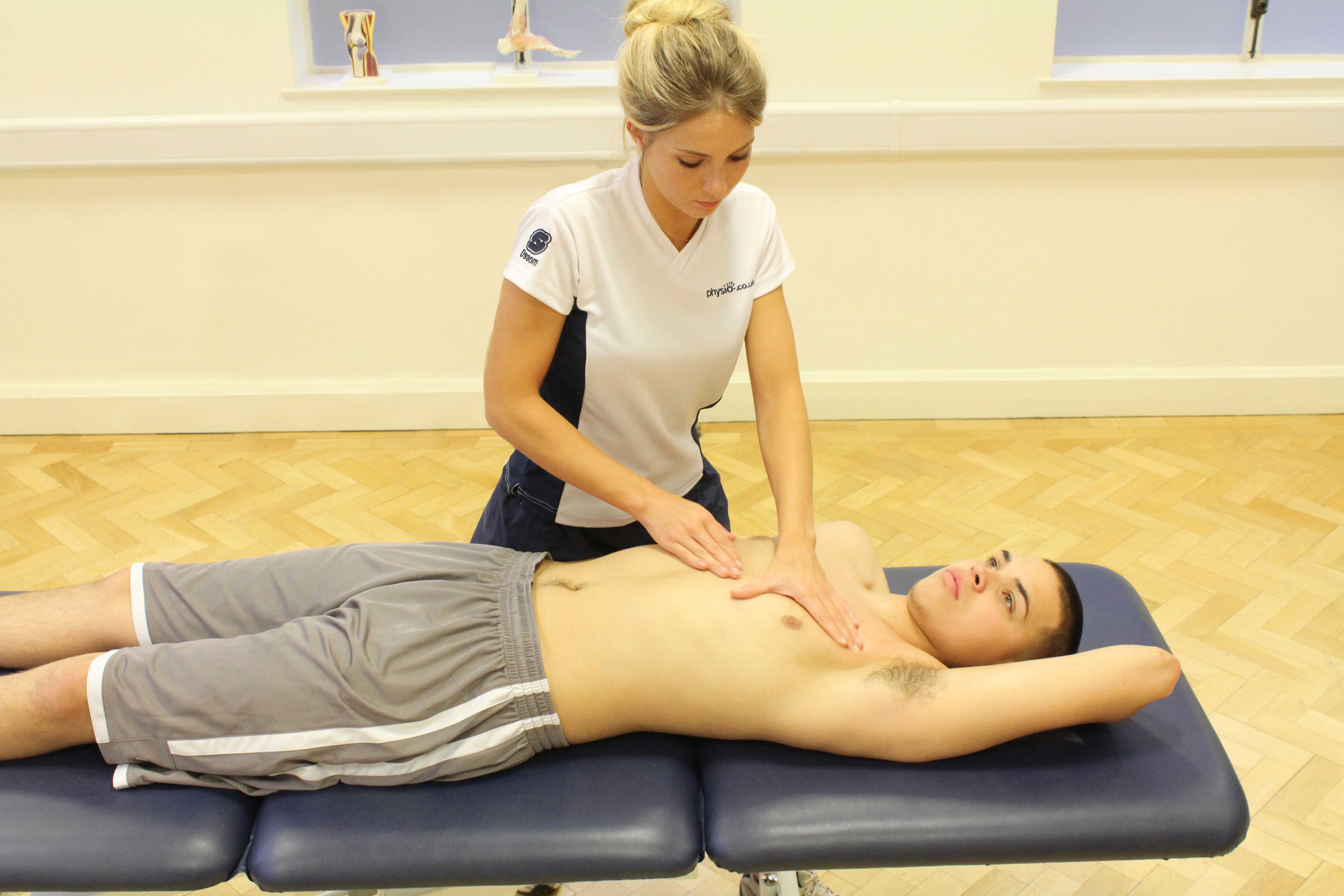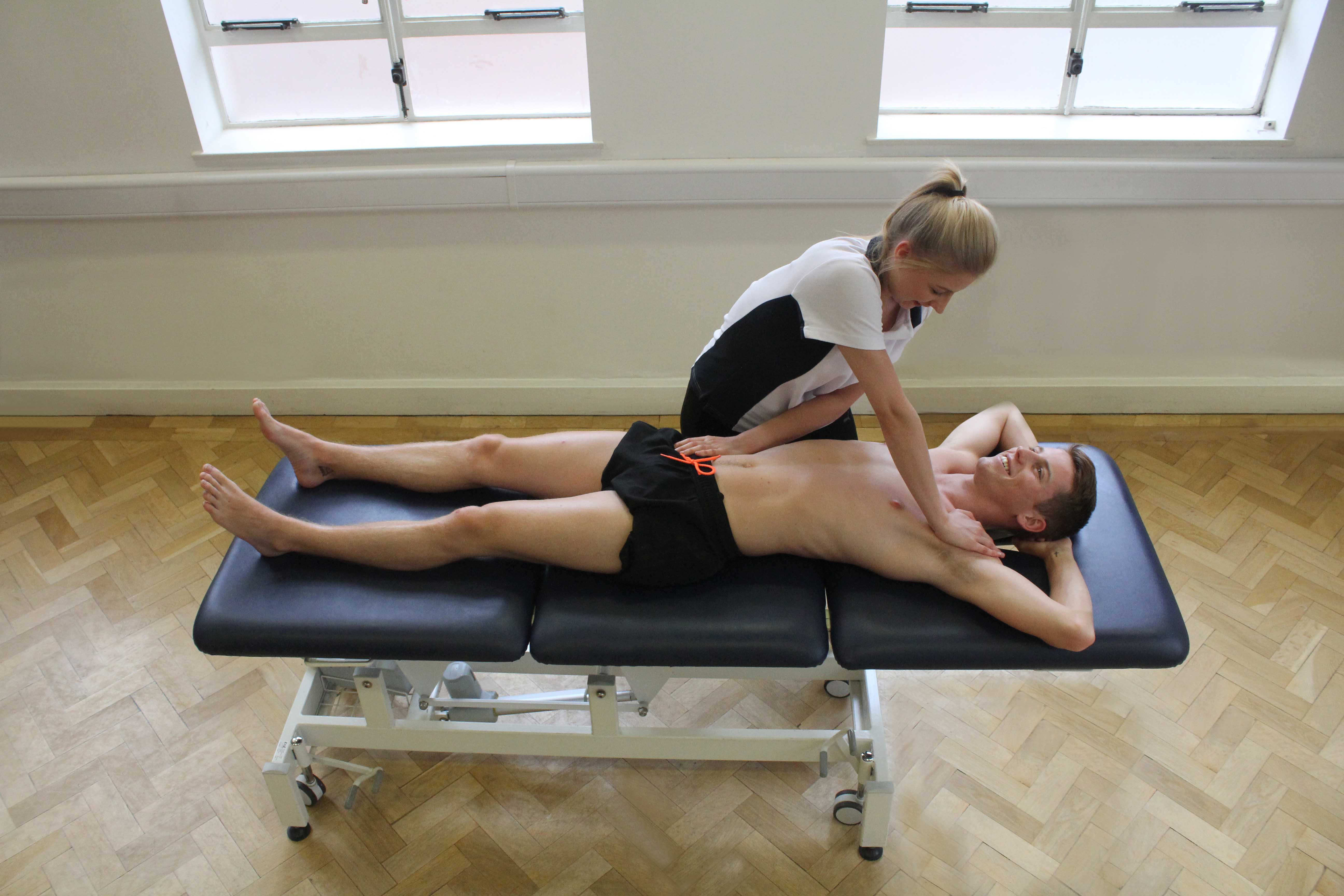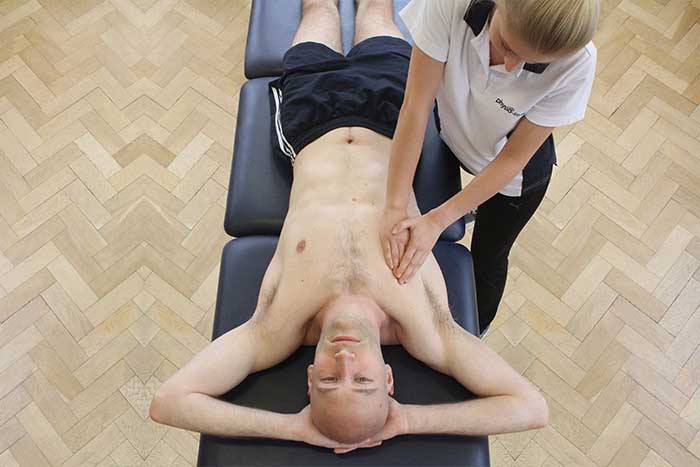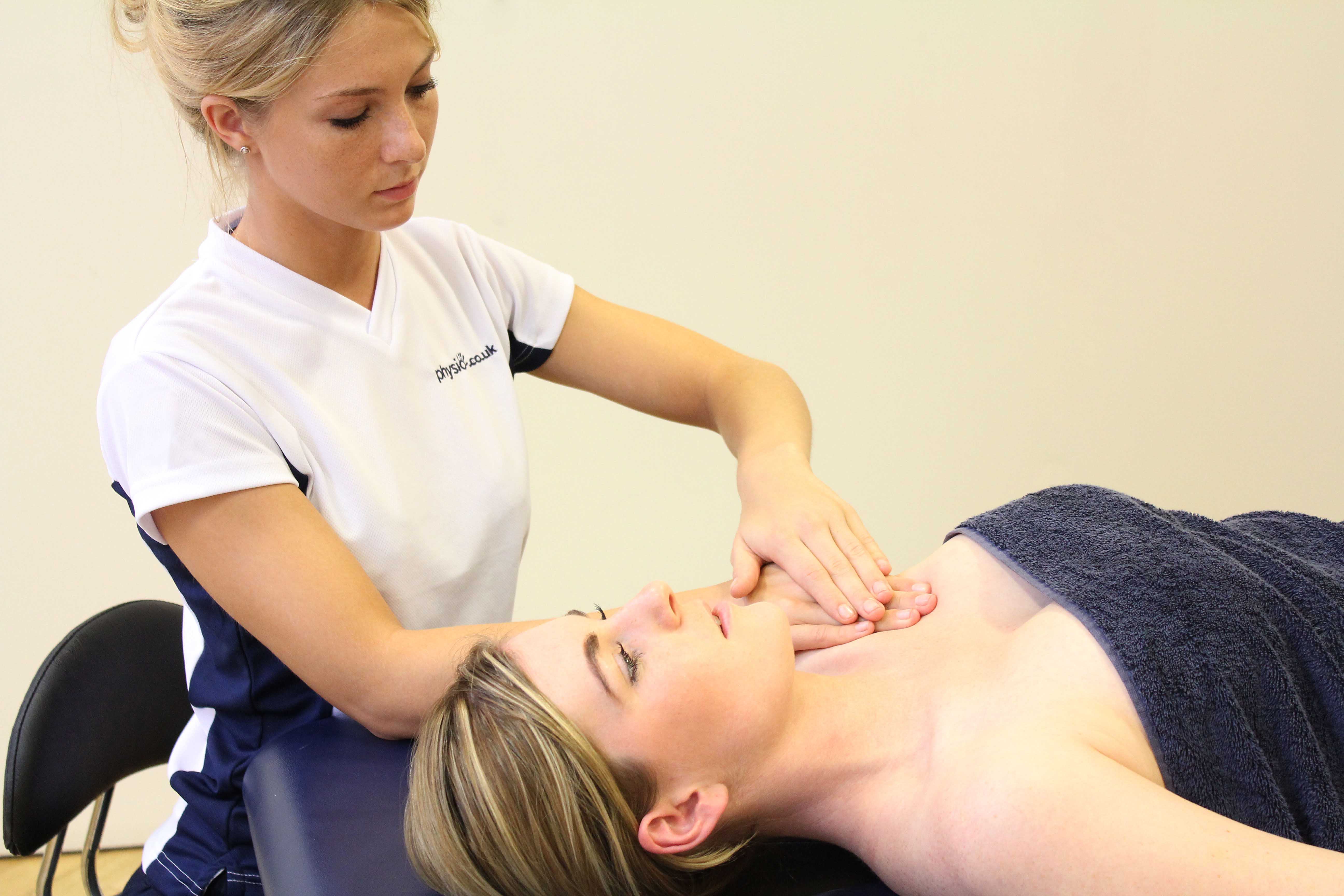A chest massage concentrates primarily on the deep and superficial muscles located around the chest area. Muscles located within and around the chest include the pectoralis minor, pectoralis major and the serratus anterior muscles. A chest massage involves a range of techniques, each used to decrease muscle tightness and pain. A chest massage can help relax the body and improve circulation. Our massage therapists at Physio.co.uk use a chest massage to relieve muscle tension, stress and pain.
What techniques are used in a chest massage?
A variety of techniques are used during a chest massage. Techniques used within a chest massage include:
 Above: Soft tissue massage of pectoralis major muscle
Above: Soft tissue massage of pectoralis major muscleFrictions are commonly used during a chest massage. Frictions are performed using the thumbs or fingertips. Frictions are where pressure is placed along muscle fibres to help break down collagen fibres. Collagen fibres can be fibrous and become restrictive resulting in pain. When using frictions, the short, circular movements, increase the temperature of the fibres. Increasing the temperature of the fibres helps them to loosen and stretch. Loosened collagen fibres, increases flexibility and reduces restriction.
Kneading is a technique used during a chest massage. Kneading is where soft tissues are pulled and squeezed. Kneading aims to reduce restriction caused by connective tissues and improve blood and lymph flow. When the muscles are being pulled and squeezed during a chest massage, the temperature of tissues increases. Increasing the temperature of the tissues allows them to stretch and increase in elasticity. Increasing elasticity reduces restriction. When muscle temperature increases during a massage, blood and lymph flow is also increased. Increasing blood and lymph flow helps to increase nutrients and oxygen in the muscles and decrease metabolic wastes. Increasing oxygen and nutrient levels and decreasing metabolic wastes, aids in the maintenance of stronger, healthier muscles.
A chest massage effectively uses trigger pointing. Trigger pointing is performed using fingers or thumbs and is where pressure is applied onto trigger points. Trigger points are located in the centre of a muscle fibre. Trigger pointing aims to soften and break down muscular knots that could be causing muscle spasms, restriction and pain. Pressure applied to trigger points causes an ischemic reaction. An ischemic reaction occurs when blood flow is restricted to an area of the body. When the pressure is released, the body detects a form of damage as cells are broken down to soften the knots. Once the body detects damage, an increase in blood flow is delivered to this area. An increase in blood flow provides the muscles with an increase in healthy nutrients and oxygen. Breaking down muscular knots and increasing blood flow reduces restriction, pain and muscle spasms.
A common technique used during a chest massage is skin rolling. Skin rolling is performed using the fingers and thumbs. Fingers and thumbs are used to pick up the skin and roll the skin. Skin rolling helps to relieve tight muscles and fascia. Fascia is a thin layer of connective tissues located beneath the skin surface. During a chest massage, an increase in blood flow occurs, rising muscle temperature. Increasing muscle temperature loosens muscles and allows them to stretch. Flexibility and range of movement is increased as muscles are loosened, therefore reducing muscle tightness. The temperature of fascia is also increased. Fascia can become restrictive resulting in pain. Increasing the temperature of fascia, improves the elasticity. Improving the elasticity of fascia reduces restriction and therefore pain.

When can a chest massage help?
A chest massage can help on many different occasions. Occasions a chest massage can help includes:
 Above: Soft tissue massage and stretching of pectoralis major muscle
Above: Soft tissue massage and stretching of pectoralis major muscleHow can a chest massage help post-surgery?
The effects of surgery can be damaging to the body. Muscles tend to become tight, restrictive and full of tension due to the decreased range of movement allowed. Tight, restrictive and tense muscles can result in high levels of pain.
A chest massage aims to reduce the effects of surgery by reducing muscle tightness.
As temperature increases during a chest massage due to an increase of blood flow, muscles and tissues are able to stretch, relax and become more flexible. Allowing the muscles to stretch and relax decreases tightness, tension and restriction. Decreasing the effects of surgery reduces pain and discomfort.

How can a chest massage help relaxation?
A chest massage can increase relaxation. When muscles become tight and painful, the body is physically unable to relax due to the restriction. Pain can also cause the body to become stressed resulting in the body being unable to mentally relax.
A chest massage aims to relax the body both physically and mentally. A chest massage helps the body to physically relax by decreasing muscle tightness and tension.
Muscle tightness and tension can be caused by many reasons, the most common being overuse and injury. During a chest massage, muscle temperature is increased due to the friction created between the skin and fingers. An increase in temperature loosens muscles allowing them to stretch and become more flexible. Loosening muscles results in the relaxation of tight and tense muscles and also reduces pain.
A chest massage helps the body to relax mentally by increasing the level of relaxation hormones called serotonin and dopamine. An increase in serotonin and dopamine reduces stress and therefore increases relaxation.
 Above: Soft tissue massage of pectoralis major
Above: Soft tissue massage of pectoralis majorHow does a chest massage help muscle tightness?
Tight muscles are relieved by a chest massage. Muscle tightness can occur for many reasons such as injury and surgery. Tight muscles can be restrictive resulting in pain.
A chest massage aims to relieve muscle tightness by increasing circulation to improve tissue elasticity.
Muscle temperature rises as blood flow increases. An increase in blood flow is encouraged due to friction being created between skin and fingers. An increase in muscle temperature allows the muscle to stretch, relax and increase movement. Muscles are able to stretch, relax and increase in range of movement due to the increase of tissue elasticity. The stretching and increase of movement of the muscles means that muscle tightness and restriction have been reduced. Relieving muscles tightness and restriction also results in a decrease of pain.
How does a chest massage help scarring?
A chest massage can treat scars. Scars can form as a result of injury or surgery, where the skin has been damaged. Damaged skin results in the build-up of scar tissue at the injury site. Scar tissue is made up of collagen fibres and helps to bring the damaged fibres back together. Scar tissue can become restrictive, causing pain.
A chest massage helps to treat scars by loosening tissues to help reduce pain and also appearance of the scar.
A chest massage increases the temperature of scar tissue. Increased temperature of scar tissue increases the elasticity. Increasing elasticity loosens scar tissue, reduces restriction and relieves pain. Loosening scar tissue allows the fibres to realign. Realigning scar tissue helps to reduce the appearance of scars.
What are the benefits of a chest massage?
Tension is decreased through a chest massage. Tension can be a result of overuse or injury. Tension is where muscle that have been used, stay contracted and do not relax, resulting in pain.
A chest massage aims to reduce muscle tension by increasing flexibility.
During a chest massage, muscles are pulled and squeezed to help loosen any restriction. The pulling and squeezing actions of the muscles increases the muscle temperature which helps loosen muscles. Relieving restriction increases the relaxation of the muscles as they are no longer contracted. Relaxing muscles increases their flexibility and reduces tension.
How does a chest massage decrease pain?
Decreased pain is a common benefit gained from a chest massage. Pain can occur for many reasons such as overuse, injury, surgery or muscle tightness. Pain is created as the brain receives a signal from the receptors that damage has occurred. The signal then gets transferred from the brain to the nerves in the body, which then create a feeling of pain.
A chest massage decreases pain by replacing the signal sent from the receptors to the brain.
During a chest massage, the friction created between the skin and fingers creates a new sensation within the body. A new sensation detected by the receptors sends a different signal to the brain, replacing the old signal. A new message is then sent to the nerves to relax the body, therefore reducing pain.
How does a chest massage increase healing?
A chest massage can increase healing. When the chest muscles are damaged due to reasons such as injury or surgery, a build-up of waste products can occur and blood flow becomes restricted. A build-up of waste products can increase healing time.
A chest massage aims to increase healing by reducing the time it takes for the damage to be repaired. Reducing time taken to heal is done by improving blood and lymph flow to the area.
An improvement of blood and lymph flow provides the damaged area with an increase in oxygen and nutrients and decreases metabolic wastes. An increase in oxygen and nutrients helps repair the damaged tissues. Decreasing metabolic wastes helps to reduce waste products that may cause healing time to lengthen. Efficient blood and lymph flow both aid in the maintenance of strong, healthy muscles.
How does a chest massage improve circulation?
A chest massage can help improve circulation.
A chest massage aims to improve blood circulation by increasing vasodilation and capillarisation.
Vasodilation is where blood vessels beneath the skin widen and come closer to the skin surface. Wider blood vessels allow an increase in blood flow around the body. When the vessels become closer to the skin surface, this allows heat and waste products to be diffused out of the body more easily.
Capillarisation is when there is an increase in the quantity of capillaries. An increase in capillaries provides the body with an increase in oxygen levels so that the body is less likely to fatigue.
Summary
A chest massage is mainly focused on the muscles located within and around the chest area. Techniques such as frictions, kneading, trigger pointing and skin rolling are used to help with post-surgery, relaxation, tight muscles and scarring. A chest massage has many benefits including decreased tension, decreased pain, increased healing and improved circulation. Our highly trained massage therapists at Physio.co.uk use a chest massage to help relieve muscle tightness and pain and improve circulation.
How can I arrange a chest massage?
The easiest way to arrange a chest massage at Physio.co.uk is to email us at office@physio.co.uk or call us on 0800 033 7800.

 0330 088 7800
0330 088 7800


































